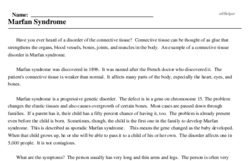Marfan Syndrome
Have you ever heard of a disorder of the connective tissue? Connective tissue can be thought of as glue that strengthens the organs, blood vessels, bones, joints, and muscles in the body. An example of a connective tissue disorder is Marfan syndrome.
Marfan syndrome was discovered in 1896. It was named after the French doctor who discovered it. The patient's connective tissue is weaker than normal. It affects many parts of the body, especially the heart, eyes, and bones.
Marfan syndrome is a progressive genetic disorder. The defect is in a gene on chromosome 15. The problem changes the elastic tissues and also causes overgrowth of certain bones. Most cases are passed down through families. If a parent has it, their child has a fifty percent chance of having it, too. The problem is already present even before the child is born. Sometimes, though, the child is the first one in the family to develop Marfan syndrome. This is described as sporadic Marfan syndrome. This means the gene changed as the baby developed. When that child grows up, he or she will be able to pass it to a child of his or her own. The disorder affects one in 5,000 people. It is not contagious.




